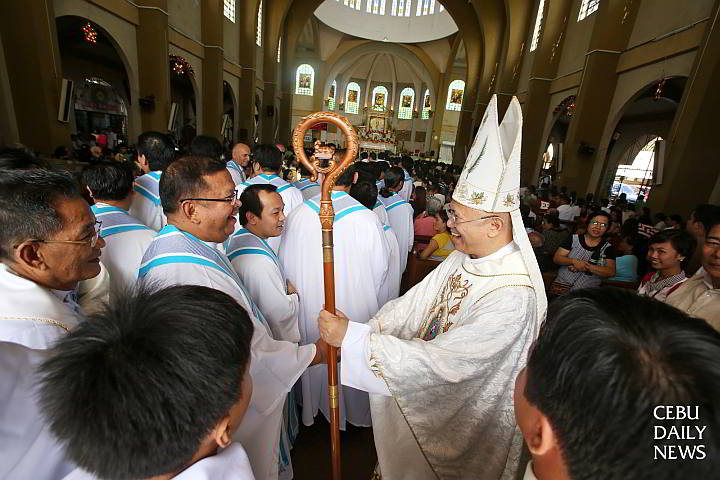Palma’s Misa de Gallo includes Carbon

Cebu Archbishop Jose Palma (right) is welcomed by other priests before the fiesta Mass at the shrine of Our Lady of Guadalupe on Friday. Instead of a church, he will be outdoors with market vendors when he celebrates the Misa de Gallo at Carbon Market on Dec. 18.
(CDN PHOTO/JUNJIE MENDOZA)
Cebu Archbishop Jose Palma will be with vendors of Carbon Market in Cebu City for the third day of nine dawn Masses that lead up to Christmas day.
The traditional Misa de Gallo, a well-loved Filipino tradition, starts on Tuesday, Dec. 16 in churches across the country.
Palma will preside over the Misa de Gallo on Dec. 18 in the city’s biggest public market, his second time to do so, said Fr. Mhar Vincent Balili, his private secretary.
Palma has three other venues.
On the 16th—the first day—the prelate will travel to Our Lady of Consolation Parish in Dalaguete town, south Cebu to preside over the dawn Mass.
On the next day, Palma will officiate Mass at the Cebu Catholic Television Network (CCTN) in Cebu City.
He will preside over the last Misa de Gallo in dawn of December 24 at the St. Joseph’s Chapel at his residence on D. Jakosalem Street.
Tradition
In the evening of December 24, Palma will lead the Christmas Mass at the Cebu Metropolitan Cathedral.
Misa de Gallo, which means “Mass of the Rooster” in Spanish begins on Dec. 16 and ends on Dec. 24.
The practice was introduced by Spanish friars in the 17th century so that farmers could attend Mass before heading off to the fields early in the morning.
The activity is associated with cold mornings, post-Mass snacks of hot chocolate and local delicacies, and special spiritual favors for those who get up early to go to church.
Exemption
The practice originated in Mexico and was attuned to the needs of rural families who needed to celebrate Mass early in the day and return to their farms to work.
The custom was brought to the Philippines as one of the Spanish influences.
“Misa de Gallo is celebrated nowhere else in the world today. The Vatican has granted special litugical exemptions to the Philippines in celebrating the Misa de Gallo,” said Msgr. Esteban Binghay.
While the Masses take place during the season of Advent, a period of penance and anticipation, Binghay said churches in the Philippines are allowed to use blue and white liturgical colors, instead of violet.
Sacrifice
The Gloria (Glory to God) is also sung during the Misa de Gallo, unlike other Catholic Churches abroad which only sing it on the eve of Christmas.
The Misa de Gallo is celebrated to honor Mary, the mother of Jesus, and to spiritually prepare the faithful for the birthday of Jesus, Binghay said.
Many mistakenly call the series of Masses “Simbang Gabi”, which actually refers to the evening or midnight Mass on Dec. 24, Binghay said.
In modern times, attending all nine-day Masses before 6 a.m. is a sacrifice for the faithful.
“There’s an element of sacrifice in attending the Misa de Gallo. But this is our way of thanking the Lord for the faith. Until now, we still have it. Let us take advantage of this so we could find meaning in life,” Binghay said.
Disclaimer: The comments uploaded on this site do not necessarily represent or reflect the views of management and owner of Cebudailynews. We reserve the right to exclude comments that we deem to be inconsistent with our editorial standards.
